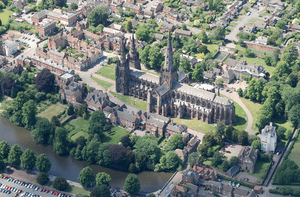Cathedral Close, Lichfield facts for kids
Imagine a special, old neighbourhood right around Lichfield Cathedral in the United Kingdom. That's The Cathedral Close! It's a historic area with buildings connected to the cathedral and the people who work there, all surrounding the magnificent church. While some buildings here are from medieval times, most of them were built much later, between the 1600s and 1800s.
Protecting the Cathedral Close
Long ago, after attacks from Vikings in the 800s, Lichfield Cathedral needed better protection. So, in the 1100s, a bishop named Clinton decided to make the Cathedral safer. He had a deep, man-made ditch dug around three sides of the Close. The fourth side was naturally protected by a lake called Minster Pool. This ditch helped create a strong, walled area around the cathedral.
Later, in 1299, another bishop, Langton, got permission to build strong stone walls around the Close and add battlements (the parts of a wall with gaps for shooting). He also rebuilt the gates. This work wasn't finished when he died in 1321.
The Close had corner towers and other towers along its walls to help defend it. There were also two main gates. The south-east gate had two towers and a drawbridge that crossed over the water from Minster Pool. This gate was removed in the mid-1700s to make it easier for horse-drawn carriages to enter.
The west gate was finished between 1322 and 1358. It was a tall building decorated with coats of arms. This gate was taken down in 1800 to make space for a new building. Interestingly, a tailor once lived in a house near this gate and used an old dungeon underneath as his cellar! The ditch around the Close was never filled with water; it was always dry.
The Civil War and its Damage
During the English Civil War (1643–1646), there were three big battles, or "sieges," around Lichfield. The people connected to the cathedral supported King Charles I, while most of the townspeople sided with Parliament. This disagreement led to the Close being fortified in 1643.
A Parliament leader named Robert Greville attacked the Close, but he was killed by a bullet from a Royalist defender. Another Parliament leader, John Gell, took over and the Royalist defenders surrendered a few days later.
However, in April 1643, Prince Rupert, a Royalist commander, led his forces to recapture Lichfield. During this attack, his engineers used explosives to break through the Close's defenses. The Parliament defenders couldn't hold out, and they surrendered to Prince Rupert.
The cathedral suffered a lot of damage during these battles. Its central spire was destroyed, the roofs were ruined, and all the beautiful stained glass windows were smashed. After the war, Bishop Hacket started to repair the cathedral in the 1660s, with help from the King. But it took until the 1800s for all the damage from the Civil War to be fully fixed.
Important Buildings in the Close
Many interesting and historic buildings are located within the Cathedral Close:
- Bishop's Palace – This grand building in the north-east corner was built in 1687. It replaced an older palace that was destroyed during the Civil War. Today, it's home to the Cathedral School.
- The Deanery – Located north of the cathedral, this building was constructed in 1707. It's a great example of the "Queen Anne" style of architecture, which was popular at the time.
- Vicars Close – In 1315, Bishop Langton gave land to the vicars (clergy who assist the priests). The vicars built their houses here, like a college, around two courtyards. The most complete row of medieval houses is along the north side of Vicars' Close. These houses are made of timber and are very old!
- Erasmus Darwin House – On the west side of the Close, this 18th-century house was once the home of Erasmus Darwin, a famous poet and doctor who was also the grandfather of Charles Darwin.



